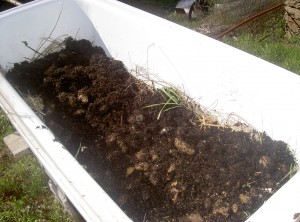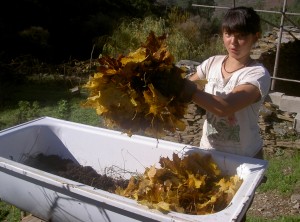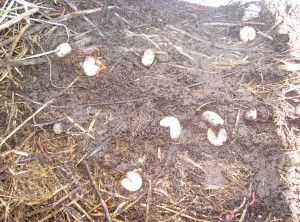We’ve currently got nine dogs. Nine dogs produce a lot of poo, and some of it needs to be collected up and disposing of. We’ve tried various ways of composting it in the past, none of which were entirely satisfactory.
This time we’re asking our composting worms to lend a hand, putting together a vermicomposting system to deal specifically with dog poo.
The system is in an old bath. The plug hole has been removed and the hole covered with fine grade mesh, so that liquids can run through but not the compost. The bath is supported on block, on a very slight angle to allow it to drain in heavy rain.
I used a layer of material from one of our existing wormeries to start it off in the bottom of the bath. Then a layer of dog poo mixed with sawdust as I collected it. Then a layer of organic material, in this case autumn leaves as there were loads lying around, another layer of dog poo, and so on. I’ll be adding another layer of organic material each time I add a bucket of dog poo. On top is a layer of old jeans or cardboard to add a little insulation in winter and a little shade in summer, then a couple of tyres to hold it all down. Eventually the card or fabric will decompose to the stage were it can get combined into the wormery and just replaced.


Left: A handful of worms plus some material from another wormery, topped with a bucket of dog poo mixed with sawdust. Right: Abby covering this with a layer of organic material, in this case leaves.
Rain will run through the material, out of the plug hole and be collected in a bucket. In a standard wormery we’d collect this liquid and use as a fertiliser, but in this case it will be disposed of well away from edibles. In the sun I find that wormeries dry out quickly, so pouring the liquid back over the top may solve two problems simultaneously, leaving me only the issue of what to do with it in particularly wet weather to worry about.
Previous experience tells me that the worms will reduce the volume of this fairly fast, but there will come a time when the bath fills up. I won’t be able to use it straight away as the top layers will still be fairly fresh, so at that point we’ll empty it out for further composting. My guess is about 6 months, but certainly time greatly reduced thanks to the worms. A handful of worms and matter from the oldest layers can be used to restart the system. If I were in a situation where I had an endless quantity of bathtubs, I’d leave it in situ to complete composting but sadly they’re hard to come by.
The finished compost will be used, as our composted humanure from the compost toilets is, on non edible areas of the site.

It didn’t take long for life to appear! Amazing what some dog poo coupled with leaves and grass can support

Leave a Reply